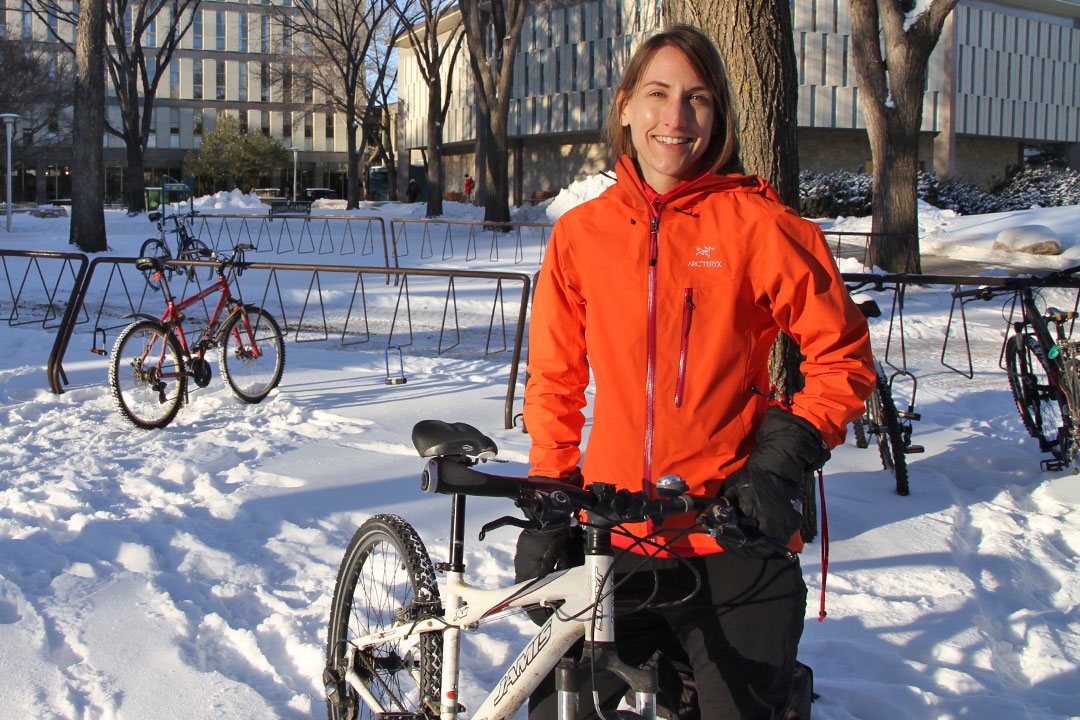
A cooler commute
Rare are the days when Leah Hildebrandt will drive to work. Instead, she prefers to knock back her kickstand and ride—year-round—on one of her two bicycles, swapping out one for the other, depending on the season.
By HenryTye GlazebrookAnd she does so even as temperatures plummet in the coldest months of the year.
“There’s no cold point when I won’t bike,” she said. “When it gets to minus 40, that’s when I just have to make sure I’m prepared for the time I’m on the road.”
Hildebrandt is a graduate secretary in the Department of Chemistry. She has been biking to campus most days for five years now, pedalling through thunderous storms, beating heatwaves and wicked winter winds alike.
The only thing that stops her is the occasional heavy snowfall, which coats parts of her commute—such as the overpass where 108th Street connects with Preston Avenue—in too much powder to make riding a sensible option.
“The wind blows across that field there. If there’s a big snowfall, that section stops me from biking that day,” Hildebrandt said. “But even if there’s not a big snowfall and the wind starts to blow across that overpass, you’ll get these big drifts. And then you’re pushing and carrying instead of biking. It’s great exercise.”
Hildebrandt’s passion for biking to work supports the university’s commitment to sustainability, with a number of initiatives designed to make cycling to campus easier, from multiple paths and bike racks across campus to events like Bike to Work Day as well as Hike, Bike and Roll.
While keeping one more car off the road is a nice bonus, Hildebrandt said cost savings was the main factor that drove her to cycling. Rather than pouring money into parking fees, insurance, gas, and the cost of a vehicle, she would rather spend that money on bikes and quality gear.
It certainly doesn’t hurt that she likes the ride, too.
“I think it’s fun,” she said. “I just think it’s an enjoyable way to get to work. And why not? If you can get your exercise in going to and from work, even that small amount is great.”
Most people assume the cold would be a big issue for Hildebrandt, but she said the act of cycling itself, coupled with the right gear, generates more than enough heat to keep her comfortable during her commute.
“I’m moving. I think sometimes people look at bikers and they pity them. ‘Oh, it’s freezing out there! Look at that person!’ But we’re actually quite warm,” Hildebrandt said. “Because we’re moving, we don’t need extremely warm clothing. I just layer up, and as long as I have a good wind layer and good gloves, I’m fine.”
In fact, Hildebrandt said she is less weighed down by the layers protecting her from the cold than she is by her backpack. Each day she stuffs her pack full of any and all equipment she might need, which ranges widely from common items like lunch, to a change of clothing for the office, to a small bike repair kit.
“Some days I feel like I bring everything but the kitchen sink with me to work,” she said, laughing.
Winter cycling is much harder on her bike than it is on her, Hildebrandt said, noting that she does regular maintenance to make sure everything’s in good shape throughout the season.
The key, though, is to install a good set of studded tires on your bike.
While more expensive than the rubber seen on summer rides, Hildebrandt said picking up a pair is an investment that will help keep you from getting up-close-and-personal with the road.
“Last year was my first time biking with good, studded tires,” she said. “The first few seasons I’d just had cheaper sets with studs only on the sides. The older I get, the less fun it is to have big bruises and to go through the adventure of trying to stay upright.”
Hildebrandt said when temperatures dip downwards of -30 C, stiff tires and frozen, creaky equipment makes getting your bike moving not unlike operating a cold car; it takes time to get everything going.
Still, she hopes such minor qualms won’t prevent more people from leaving their regular drivers at home and trying out a winter bike ride, even if sharing the road isn’t always easy.
“Cars are probably my biggest concern,” she said. “You can slip around a bit in a car, but there’s not another car right there beside you. When they drive so close as they’re going by you on a bike, it’s concerning. But I can’t stop cycling just because I’m worried someone will hit me. It’s just part of what you take with this, and you hope that everyone will respect you.”
Pedal power points
As a veteran winter cyclist, Leah Hildebrandt knows the vital equipment that you’ll need if you want to try pedalling through snow for yourself. Here are her top five items:
- Studded tires: A thick set of well-studded tires will keep your bike upright and keep you off the ground.
- Snowboard helmet: Unlike their biking counterparts, snowboard helmets allow you to secure goggles over your eyes while you ride, making facing the snow easier on your field of vision.
- Gloves and footwear: Extremities are the first body parts to cool down, especially when you’re moving quickly. Keep your digits and toes protected.
- Layered clothing: Staying warm is key to turning winter activities from a chore into a breeze. Invest in good outerwear and layer appropriately for best results.
- A second bike: This one isn’t a necessity, but Hildebrandt says that the wear-and-tear on your ride will vary greatly, depending on the season. If you can manage it, a second bike will simplify things greatly.

